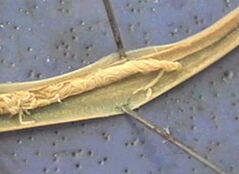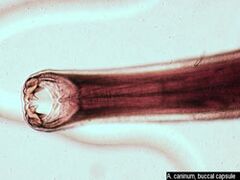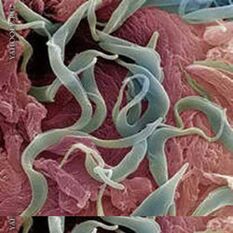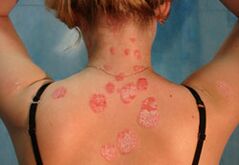Many people leading to a healthy lifestyle have health disorders due to the presence of parasites.Highing the body (proper nutrition, exercise, hardening procedures), without eliminating the body from parasites, does not have a pronounced positive effect.According to the World Health Organization, helminths are located not only in the gastrointestinal tract, but also in the vital organs: brain, heart, lungs, liver, kidneys.Helminths in the processes of their lives distinguish special substances - toxins that are strong poisons and allergens.It is the simplest, fungi and helminths, which are the mechanism of triggering many chronic diseases: cholecystitis, cholelithiasis, pancreatitis, colitis, diabetes mellitus, bronchial asthma, atopic dermatitis.

Chronic fatigue, irritability and anxiety, hyperactivity in children, anemia, brittle nails and hair, problem skin, headache, appetizing disorders, reduction of immunity - these can be the signals of the present disease.With a long stay of parasites in the human body, the immune system suffers significantly.In the process of constant combating foreign antibodies, it comes to exhaustion, that is, the development of secondary immunodeficiency.Parasite disease leads to hypovitaminosis, depletion of trace elements: potassium, copper, manganese, selenium, zinc, magnesium, silicon;Disruption of hematopoiesis, hormonal insufficiency, vascular permeability is impaired, the protection against cancer of the body suffers.
For millennia, people, mainly planted food, have received antimicrobial, antiparasitic and antiviral natural active substances with it.Reducing the consumption of wild plants, fruits, fruits, replacement of their vegetables and fruits, thermal and industrial treatment has reduced the consumption of natural volatile and antibiotics.As a result, a person has become easy prey for many microorganisms.The intensive development of the drug industry that produces antibiotics has led to a decrease in immunity.
Determination of parasites

Parasites (from Greek. Parasitos - overlap, parasite) - lower plant and animal organisms living outside or inside another organism (owner) and eat at his own expense.The parasites arose in the process of historical development of organisms from freely living forms.Adaptation to certain living conditions led to the simplification of their organization, the development of special fixing organs, increased development of the genital organs, breathing, which makes it possible to exist in a fearless environment.Parasites include many helminths, fungi, viruses, protozoa, worms, crustaceans, cobwebs, shaped, insects.Parasite owners can be bacteria, the most simple, plants, animals and humans.The parasites undergo a complex cycle of development: sometimes they need a change of 2-3 owners whose body is intermediate (helminths pass the stages of larvae) or extreme (helminths become mature, invasive).Parasites cause weakening and depletion of the host's body, causing a number of diseases.
Helminants can parasitize in all tissues and organs of a person, but the most common place in their localization is the food tract.Bull and Pork Tapeworm, a wide band are fixed at the top of the small intestine, also parasitize Ascaris.The dwarf dashboard is located mainly in the lower third of the small intestine, the hair - in the colon, opistorchis - in the biliary passages of the liver and the ducts of the pancreas, the pinari - in the lower parts of the small and in all parts of the colon.In this way, the distribution of different types of helminths along the digestive tract in search of the most favorable living conditions provides them with individual survival and creates conditions for the development of several species in the body of one person.
Classification
Through distribution:
- Ubiquette - meet everywhere.
- Tropical - distributed in tropical climatic zones.
According to biological and epidemiological characteristics: Geohelmints - a disease in which helminths first develop in the human body, and then on a non -living substrate, more often in the ground.BioHelminths is a disease in which a biological cycle of helminth development is necessarily carried out in the body of other living things except humans.Distinguish the final owners in which the helminths develop to a sexually mature stage, as well as to the intermediates, where the parasite is in the stage of the larva or its reproduction is not sexual.One is more often the final host, more rarely intermediate.Helminthiasis is a disease in which parasites are distinguished from the human body by mature or almost mature, resulting in an infection of another person or re -infecting.
Depending on the location of the parasite in the body: education - living in the intestinal cavity and other cavities of a person (eg ascaris, tape) and tissue - living in the tissues.

In place of the owner's stay:
- External (mosquitoes, blinds, leeches, lice).
- Internal (Helminthiasis):
- Roundworms (nematodes - ascarids, Vlasov, pinburies, strings);
- Flat worms:
- trematodes (plates - cat bickelter, schistosomes);
- Castodi (red worms - a bull and pork tape, dwarf boards, wide strip, echinococcus).
- Bacteriosis (Staphylococcus, Streptococcus).
- Protose (Amoebas, Lamblia, Trichomonas, often owners of Chlamydia and AIDS virus).
- Mycoses (fungal diseases) -for example, Candida.
How are the parasites adapted
- Long life expectancy (helminths have lived in the body for years, and sometimes as much as the parasite owner lives);
- The ability to suppress or change the immune response of the host's body (a state of immunodeficiency occurs, conditions are created to penetrate pathogenic agents from the outside, as well as to revive the internal focus of the infection);
- Many types of helminths, entering the digestive tract, distinguish the anti -enzymes, which saves them from death;The digestive process is impaired, toxic allergic reactions occur, which are different in gravity: urticaria, bronchial asthma, atopic dermatitis;
- Stage of development (egg, larva, change of owners);
- the ability of eggs for years to continue in the external environment;
- Sexual reproduction in which genetic information exchanges and this is the highest stage of development, which leads to an increase in heterogeneous population, that is, the parasites become less vulnerable;
- The lack of immunoprophylaxis as the immune response is weak and unstable;
- Helm widespread, many habitats (water, soil, air, plants and animals).
How parasites enter the body

You can not only get infected through dirty hands.Animal hair is the carrier of worms (ascaride), lamblia.Pinc worm eggs that have fallen from the viability of the wave to 6 months and through dust, toys, carpets, linen and mats and hands fall into the food tract.The dog through wet breathing spreads the eggs at a distance of 5 meters (cat - up to 3 meters).Dog fleas also tolerate worm eggs.Askarid's eggs enter the body through poorly washed vegetables, fruits, berries, green, dirty hands and are also spread in flies.And improperly boiled barbecue or home -made lard is the path of trichinosis infection;Poor salty fish, caviar - optistorchiasis and wide band.
So, there are several ways to enter the body:
- Alimentary (through contaminated food, water, dirty hands);
- Contact house (through household items, from infected family members, pets);
- Through blood inhabiting insects;
- Active (in which the larva penetrates the skin or mucous membranes during contact with infected soil when you bathe in open tanks).
Prevention
Here are some rules that must be followed to prevent parasites from entering the body:
- It is not recommended to drink water from natural sources and in an unfamiliar area.
- You cannot eat unwashed vegetables and fruits.
- It is advisable to beware of mosquitoes, ticks and other blood suffering from blood, which can be carriers of parasites.You need to use special remedies against them, and in places where there are many of them, wear long -sleeved trousers and shirts.
- Before traveling to some countries, it is necessary to vaccinate from typhoid fever, plague, tropical fever and other infectious diseases.Going to the places where the malaria mosquito is found, you should take anti -dimensional tablets.Collecting a long journey where ticks can be, it is important to vaccinate from tick encephalitis.
- Do not allow children to hug and kiss dogs, cats and other pets. Take care of your pet's health - take them to disinfect courses.
- Follow the rules of personal hygiene, maintain the cleanliness of the house.
- Conduct periodic preventive anti -parasite courses for the whole family.
Children and parasitic invasions

The most vulnerable of the effects of parasites are children.They are infected with different types of parasites through dirty hands, sand, soil and water.Sometimes the infection of the child can occur in intrauterine, as the simplest larvae of bacteria, viruses, candida and helminths can penetrate the fetus through the placenta with blood flow, as well as during birth through the birth canal.Due to the expansion of their motor activity, at the age of 1.5-3 years, children can be infected at home, for a walk, in kindergarten, when connected to contaminated objects (street shoes, floor, toys, common areas), on the street (play in the sand box or in the ground), as well as in contact with animals (Vagabonds or home).The high likelihood of parasite invasions is observed in mismatch with hygiene rules (unwashed hands, eating unwashed vegetables and fruits, eating raw water from natural ponds and swimming in them).Only eggs from Pinari and dwarf tapeworm are transmitted directly from person to person.Eggs from other ripening helminths must necessarily enter the body of an intermediate host or a suitable environment - soil or water.At the age of 1.5-3 years, the scale of infection in children with helminths can reach 80%.
More than 90% of all helminth diseases in children are caused by intestinal nematodes, which parasitize in the lumen of the intestine (Ascaris, Pinworms), nematodes parasitic in the intestinal wall or other organs (ankylostom, non -cycinel and intestinal uctuma) are more common.In children subjected to elementary hygiene (impressions of raw or thermally insufficiently processed meat or fish, unwashed vegetables and fruits, non -functional water from natural tanks), there are virtually no worms (trematodes) and herbiars (cestodes).
How can a child become infected?
The infection is performed when egg larvae enter the body.Eggs enter the environment with stools of infected humans and animals.They are microscopic sizes, are very resistant to various influences and can maintain vitality for a long time outside the body (in the soil, on the surface of objects or products, in the folds of linen, on the skin).Once in the oral cavity of the child, the eggs of the worms pass, partially destroy, through the acidic, aggressive environment of the stomach and activated in the intestine, where the conditions for the development of adult eggs are most favorable.Children from pre -school and pre -school age are particularly susceptible to helminth invasions as they still have imperfect barriers of the gastrointestinal tract.
Measures to prevent helminthiasis in children: for all family members to observe the rules of hygiene, try to prevent the child's close contact and his or her personal belongings with pets;It is important to ensure that the child does not choose different objects;preventing contact with animals;It is important to inspire your child's personal hygiene skills (wash his hands with soap after the street and visit the toilet);It is advisable to periodically conduct wet cleaning at home, wash with soapy toys, especially in the presence of pets, as well as toys brought from walking to the house;Vacuum carpets, upholstered furniture and upholstered toys;Do not give your child with immersive vegetables and fruits, not enough thermally unprocessed meat and fish, raw water from natural tanks.
Signs of helminth invasion of children

Most often, a child must guess for the Helmintic invasion through indirect signs.The likelihood of helminth invasion is very high if the child has such symptoms as: in love, nausea, decreased appetite or pathological enlarged, spasms of pain around the navel or without a certain localization, by appearing, regardless of food intake, disorder of stool (diarrhea, closed), frequent pads or dizziness.Palmore, Palire, Paller and Frequent pads or dizziness, palmore, palor, paralor and honor embellishment or dizziness, palor, palior and frequent pads or dizziness, Palor and Paleor, Palor and Pale Sineva or Dizziness, Palor and Palor, Palor and PalorNight sleep, accompanied by screaming, awakening, "fixing", grinding teeth, itching in the perineum.Often parasites lead to allergies of the body, skin reactions occur in the form of atopic dermatitis (as a rule is persistent, which is difficult for symptomatic therapy).If the worms are in a child or in one of the family members, it is necessary to treat the whole family to avoid the formation of the focus of the infection.In this situation, it is important to strengthen hygienic measures, in particular, warts and iron on both sides of linen and personal underwear.
























